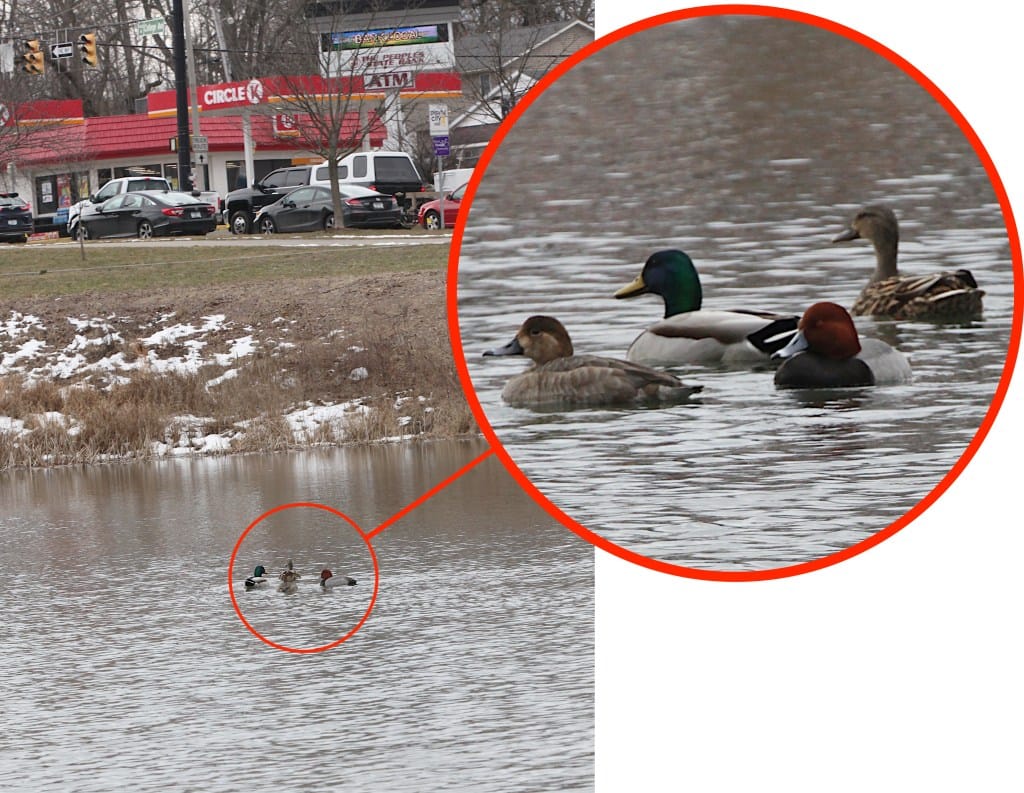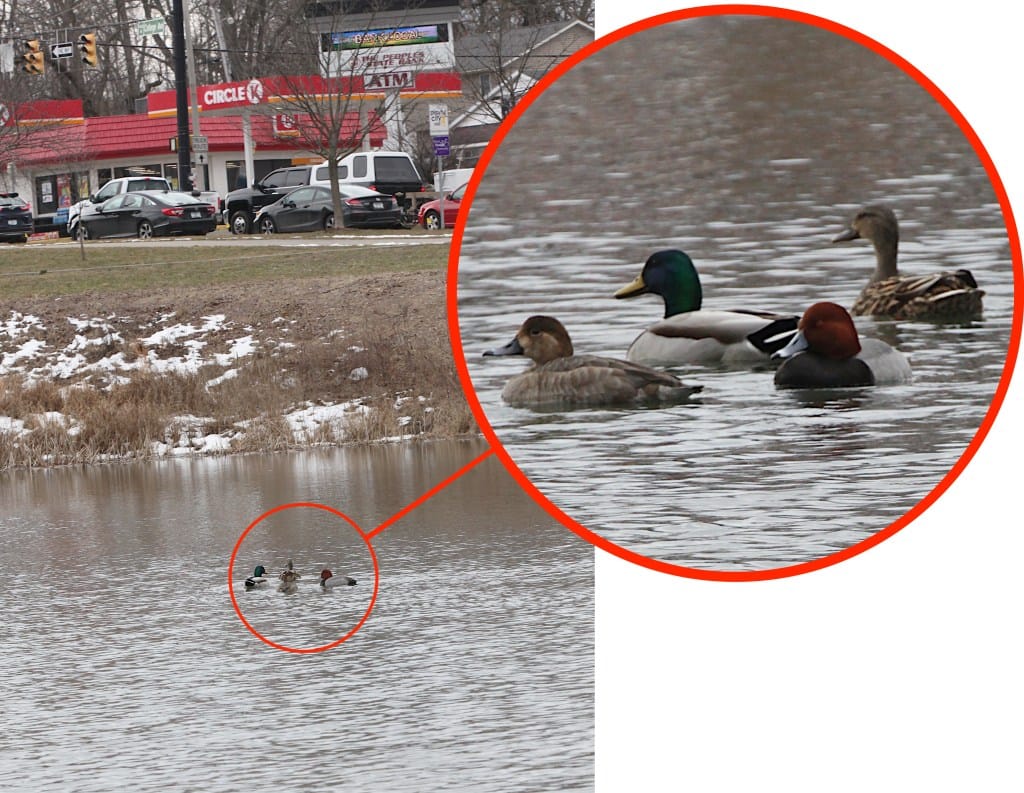Column: Behold the Redhead ducks at Bloomington’s Miller-Showers Park!



Miller-Showers Park is wedged between two of Bloomington’s heaviest-travelled roads—Walnut Street on the east and College Avenue on the west. On the south, the park is bounded by 17th Street. A bit to the north is State Road 46.
Those roadways combined carry something like 50,000 vehicles a day.
About 10 days ago at Miller-Showers park, the bird count included: 9 Snow geese, 4 Canada geese, 9 Mallard ducks, 1 Red-tailed hawk, 20 European starlings, 8 Redhead ducks.
It’s INDOT that counts the cars on the roads.
But who counts the ducks on the park’s stormwater ponds? Not me. Those counts came from someone else. I have only looked at them. The first time was last Sunday.
Among the Canada geese that I saw—and the “regular” ducks that everyone has probably seen before—were some ducks with red heads. I am not an outdoorsman. So they struck me as somewhat exotic.
I was intrigued enough that I returned to Miller-Showers Park a couple days later to see if I could get some better photos.
Did these glamorous crimson-headed birds have a commensurately glamorous name? No, that’s apparently not how ornithologists approach their naming task. Ducks with red heads are called Redhead ducks.
Photos: Miller-Showers Park (Feb. 24, 2021)
Click to view slideshow.One way to tell that Redheads are a little bit special is from the point system that was at one time in place in the middle part of the country to define a duck hunter’s daily limit.
A Redhead counted as 70 points towards a daily limit of 100, according to Chris Hull, who’s the communications guy for South Dakota’s Game, Fish and Parks agency.
That’s more than three times as many points as some of the lesser 20-point ducks. You could go over 100 points, but only if the total before your final duck was still less than 100 points. That meant you could start by shooting four 20-point “blue bills” and still shoot a Redhead to close out the day.
Hull told me the first two ducks he ever shot, as duck hunting kid, were Redheads. Having shot his two Redheads, the point system meant his day was done. Hull said, “My dad was like, ‘You’ve seen us do this! You don’t shoot those Redheads right away!’” Hull added, “I just remember sitting there being really cold watching those guys shoot ducks while sitting there with my two Redheads.”
About Redheads, Hull said, “They are really still my favorite ducks, because that’s what we chased after when I was a kid.”
It’s not bizarre that there are Redhead ducks at Miller-Showers, but it is a little unusual. That’s according to Adam Phelps, a waterfowl research biologist with Indiana Department of Natural Resources.
Phelps said, “It is unusual to see diving ducks on water as small as this.”
Why does Phelps figure they decided to hang out at Miller-Showers? “There could be a couple of different things going on. It could just be that this is where they found open water and they needed to sit down, or there could be something there that legitimately attracts them,” Phelps said.
A better place to see Redheads is Lake Monroe, according to Phelps. He added, “We have good local populations of migrating redheads in early spring. They do not breed in Indiana.”
They’re migrating? I guess that means: Go now. Go now to Miller-Showers Park and see these beautiful creatures for yourself.
That’s not just my advice. It’s the same counsel I got from Cory Lamping, who’s a Bloomington resident with a burgeoning interest in ducks and waterfowl.

Lamping says: “They will start migrating back north pretty soon so I would get out there and try to get pictures of them while they’re still hanging around.”
It was the middle of the day when I happened to spot the Redheads.
When is the best time of day to see them? Lamping told me “early-ish in the morning” is good, maybe a little before 9 a.m. Lamping added: “But I’ve seen them in the evening and in the middle of the day as well. They’re probably feeding and roosting there, because it is sheltered. It’s a good roosting place.”
The Redheads probably feel safe among the Mallards, and Canada geese that are roosting there, Lamping said. Lamping added “A lot of the Mallards, in the early morning and overnight, might leave to go feed in cornfields. But as far as I know Redheads don’t feed in cornfields very often. So they’re probably staying there more or less around the clock.”
It was Lamping who alerted an acquaintance, Katharine Khamhaengwong, to the presence of the Redhead ducks at Miller-Showers. And it was Khamhaengwong, who did the counts that are listed out at the start of this column. She’s an Indiana University graduate student in Eurasian studies, so her studies aren’t focused on birds.
But her time in the country of Georgia—where she was living for the two years before she arrived in Bloomington—gave her some birding experience. She volunteered for a project that counted raptors as they migrated along a flyway from Africa to Northern Europe and Russia. “I spent probably a month and a half to two months there, over the course of two years, just counting raptors,” Khamhaengwong said.
About her expertise, Khamhaengwong said, “I know a lot about Eurasion raptors, and not that much about North American birds at this point.” She described herself as somewhere between an amateur and a pretty committed birder. She thinks it will not be too hard to reach her current goal for bird sightings. “I’m trying to get to 100 birds [species] in Monroe County this year.”
On the mid-February day when Khamhaengwong went to Miller-Showers and logged her count on eBird.org, she went specifically to see the Redheads.
For the last two months, she’s been trying to find some pretty, migratory ducks. So she’s been visiting the ponds around town that are within walking distance—she doesn’t own a car. But she has not had much luck.
About her sighting of the Redheads at Miller-Showers, she said, “As someone without a car, I was super excited that there was a cool duck in town.”
Photos: Miller-Showers Park (Feb. 21, 2021)
Click to view slideshow.



Comments ()